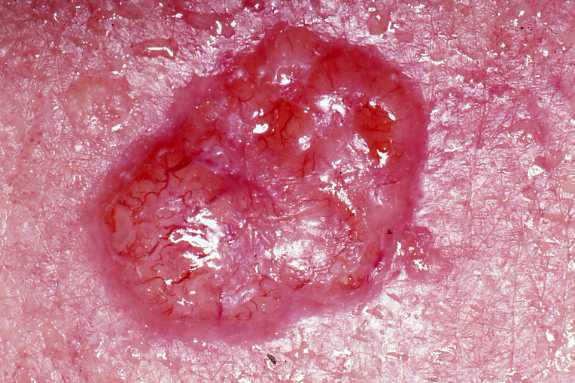WBR0800
Jump to navigation
Jump to search
| Author | [[PageAuthor::Gonzalo A. Romero, M.D. [1]]] |
|---|---|
| Exam Type | ExamType::USMLE Step 2 CK |
| Main Category | MainCategory::Surgery |
| Sub Category | SubCategory::Dermatology, SubCategory::Dermatology |
| Prompt | [[Prompt::A 72-year-old male farmer of Norwegian heritage comes to the clinic complaining of non-healing ulcer located on his face. It is indolent in nature. The patient states that it has been growing slowly over the past 2 years. On physical exam it has a punched-out appearance, it is clean, has 1.5 cm in diameter and is located over the right temple. There are no lymphadenopathies. What is the best next step in management?
 |
| Answer A | AnswerA::Fine needle aspiration |
| Answer A Explanation | [[AnswerAExp::Incorrect. This will disrupt the malignant cells configuration and could potentiate the spread of the tumor.]] |
| Answer B | AnswerB::Drainage |
| Answer B Explanation | [[AnswerBExp::Incorrect. This is recommended in cases of abscesses.]] |
| Answer C | AnswerC::Antibiotic therapy |
| Answer C Explanation | [[AnswerCExp::Incorrect. Antibiotics are recommended for skin infections such as cellulitis. In occasions, tumors can ulcerate and become over infected requiring antibiotics. In the vignette the patient does not present with signs of infection.]] |
| Answer D | AnswerD::Full thickness biopsy at the edge of the lesion |
| Answer D Explanation | [[AnswerDExp::Correct. See overall explanation]] |
| Answer E | AnswerE::NSAIDs |
| Answer E Explanation | [[AnswerEExp::Incorrect. This anti-inflammatory agents are recommended for multiple rheumatologic diseases to treat mild symptoms. Some rheumatologic conditions can manifest with skin changes such as SLE. SLE can have skin manifestations such as malar rash or oral ulcers, which require Disease-modifying antirheumatic drugs (DMARDs)]] |
| Right Answer | RightAnswer::C |
| Explanation | [[Explanation::Basal cell carcinoma (BCC) is the most common form of skin cancer. It can be destructive and disfiguring. The risk of developing BCC is increased for individuals with a family history of the disease and with a high cumulative exposure toUltraviolet light via sunlight or, in the past, were exposed to carcinogenic chemicals especially arsenic. It is a malignant epithelial cell tumor that begins as a papule (a small, circumscribed, solid elevation of the skin) and enlarges peripherally, developing into a crater that erodes, crusts and bleeds. As shown in the picture it presentes as a raised lesion, erythematous, shiny, with telangiectasias that can erode and bleed. Metastasis is rare, but local invasion destroys underlying and adjacent tissue. In 90 percent of all cases, the lesion is seen between the hairline and the upper lip (upper half of the face). The best next step is to perform a full thickness biopsy at the edge of the lesion. A complete excision with a narrow margin of uninvolved skin is also recommended.
Educational Objective:
Educational Objective: |
| Approved | Approved::No |
| Keyword | WBRKeyword::Skin cancer, WBRKeyword::Basal cell carcinoma, WBRKeyword::squamous cell carcinoma, WBRKeyword::biopsy |
| Linked Question | Linked:: |
| Order in Linked Questions | LinkedOrder:: |